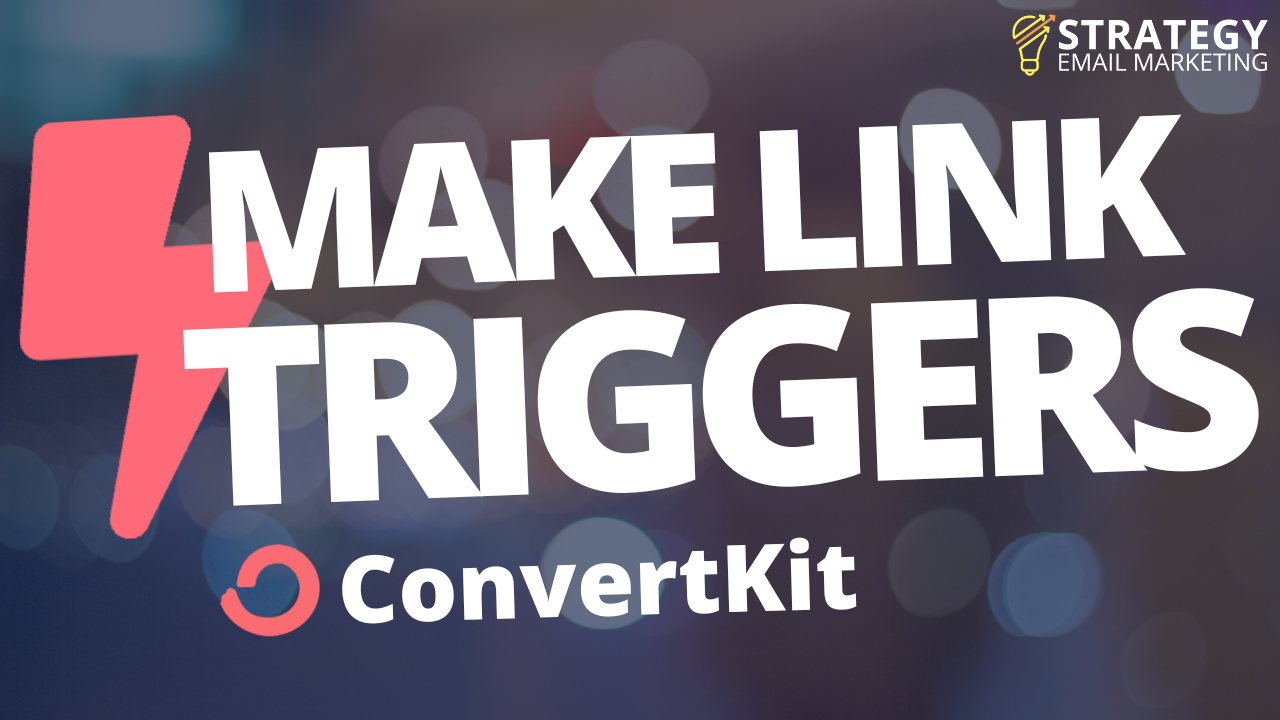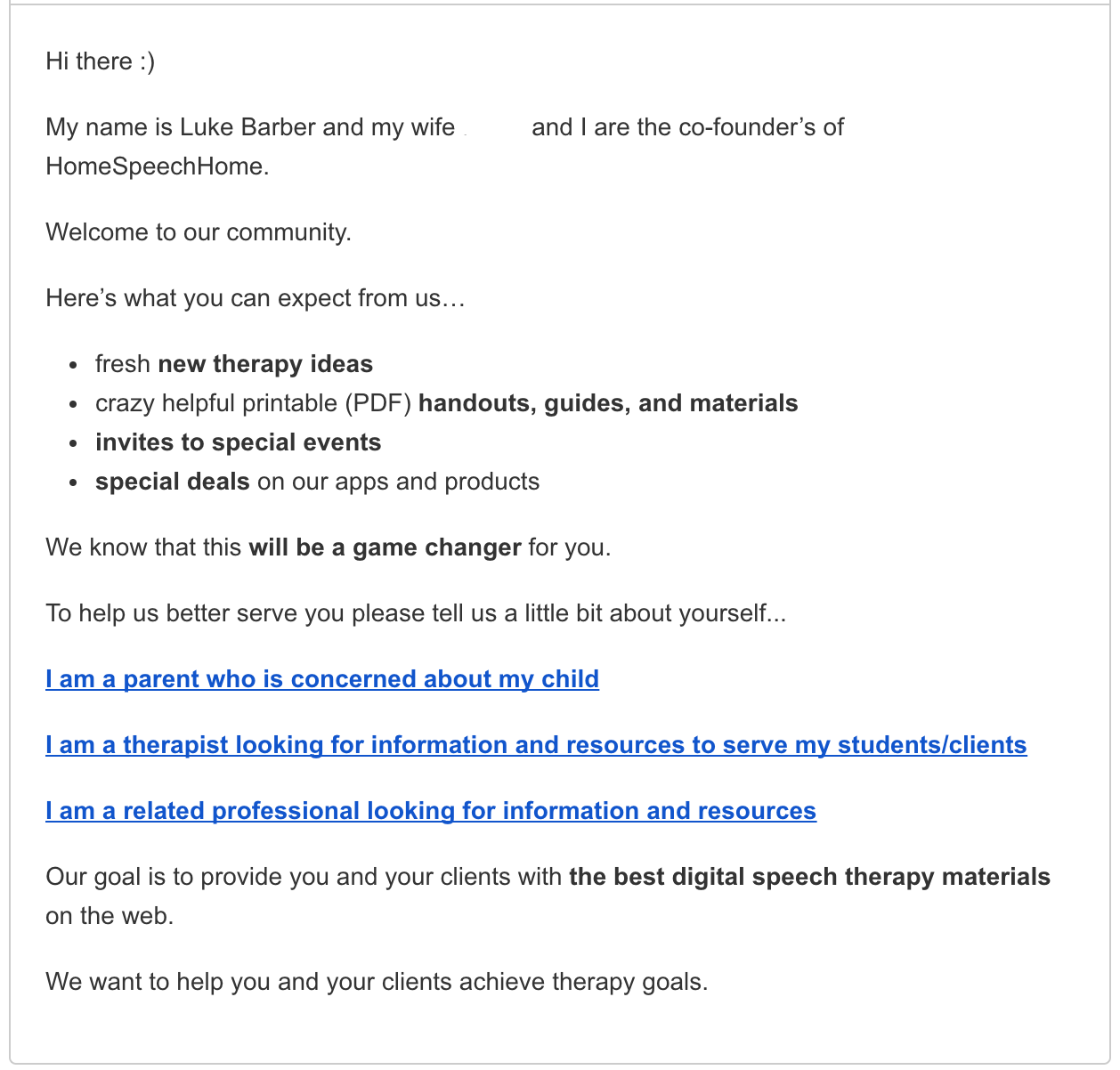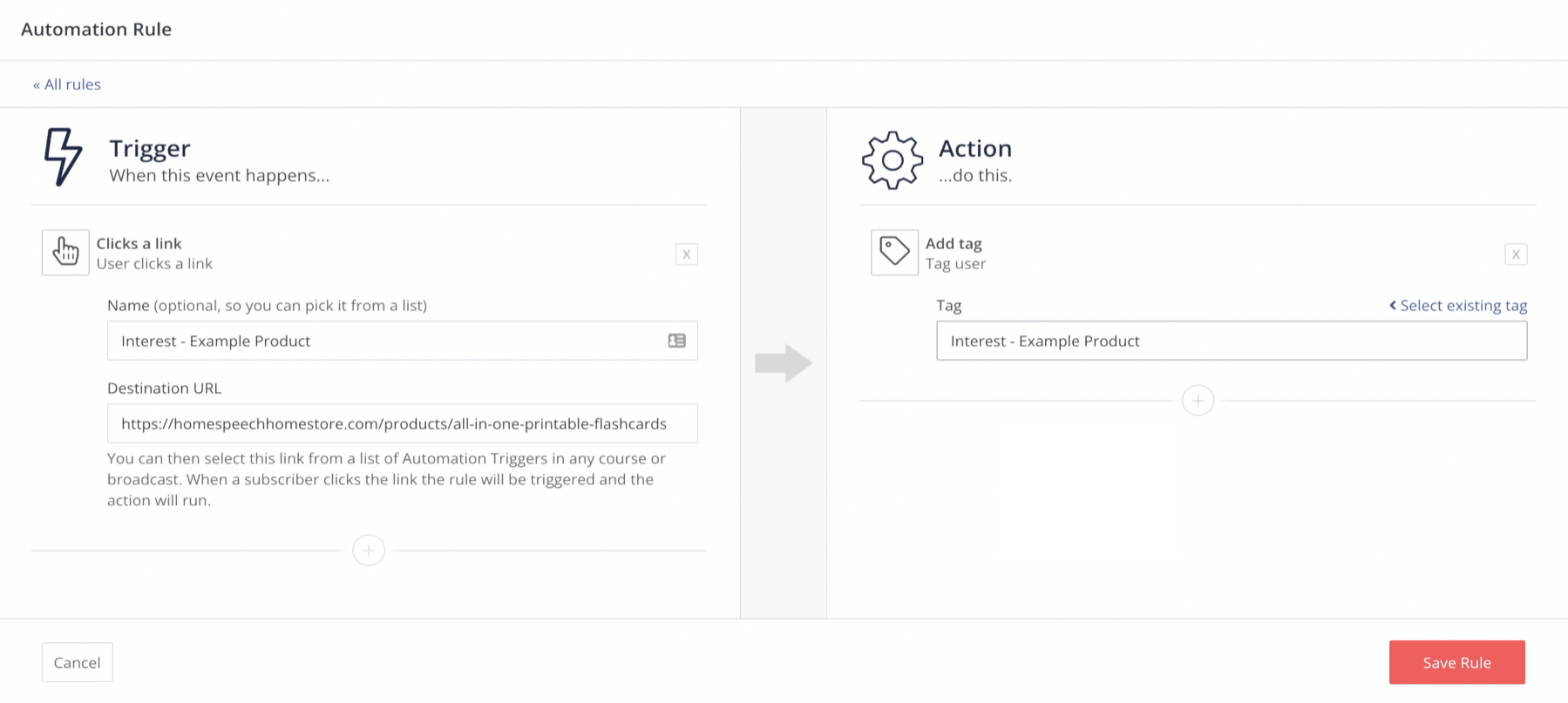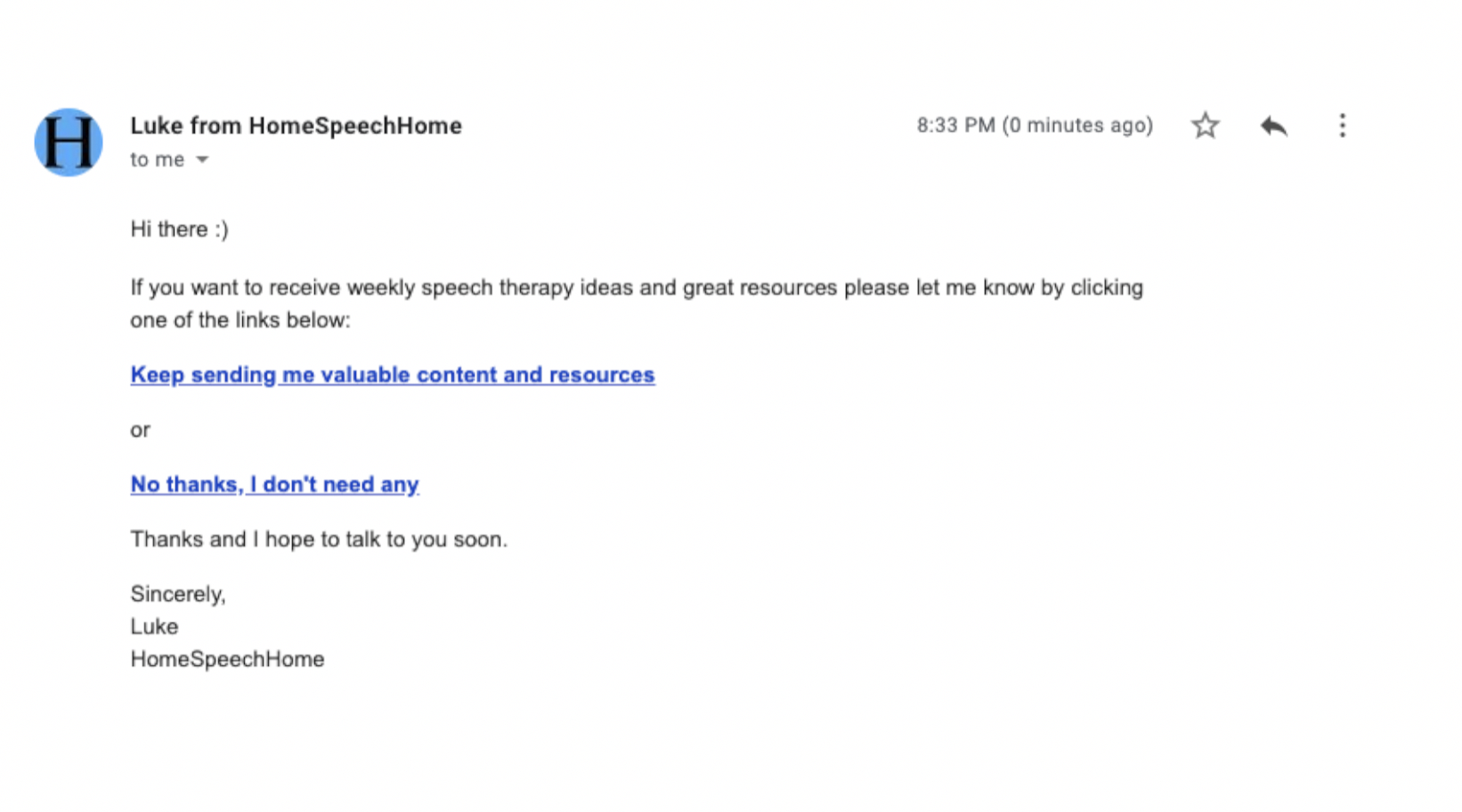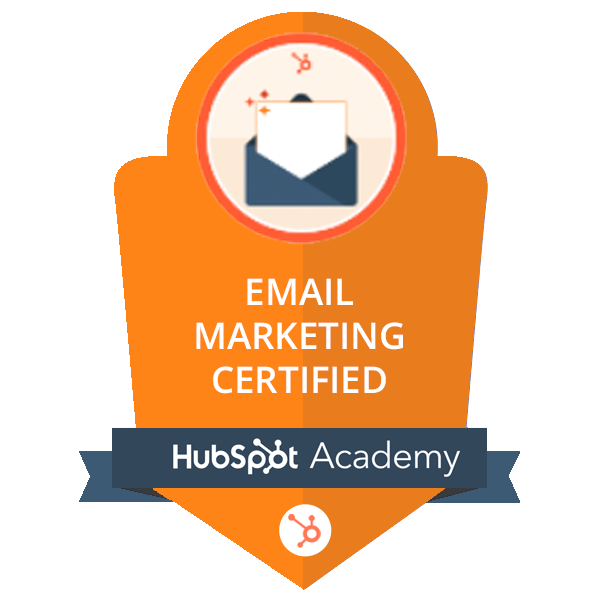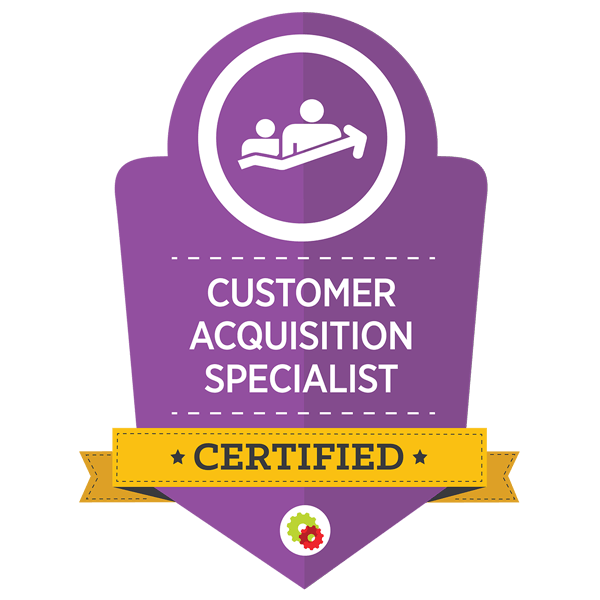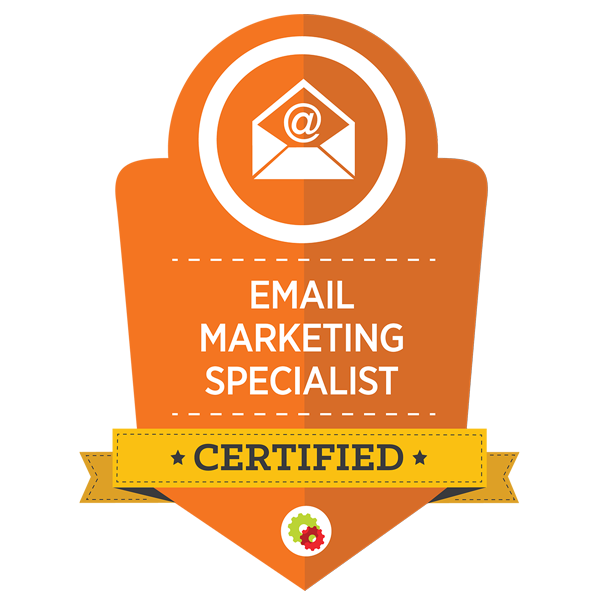Make ConvertKit Link Triggers &
Automate Your Email Marketing
Let me show you how to use ConvertKit link triggers.
I'm also going to tell you about four different ways you can use link triggers to automate your email marketing, so it runs like a well oiled machine.
After I log in to Convert Kit, I'm going to click on Automate and then Rules.
I'm going to click on "New Rule", scroll down and I'm going to click on "Clicks a Link".
Then I'm going to name my trigger because after you do this a bunch and you set up a bunch of these, you're going to want to name them so that you can find them quickly because you have to pick them from a list.
I'm going to call this link Interest in my Example Product.
I'm going to go to my product page and I'm going to highlight my product page link. I'm going to copy it, and I'm going to paste that link in the destination URL.
Once the link is built, when somebody clicks on it, it's going to trigger something else.
The next thing I'm going to do is go to the action.
The action is, I want the person to be tagged as someone who is interested in the example product.
Don't get confused because you have example product and example product, one link is the trigger and the other is the action.
Once they click a link, I want it to show that they're interested in that product.
Then I'm going to go to save Rule.
Then I'm going to go to Send Broadcast and create a new broadcast and I'm going to put the subject line as "Product Sale".
Then in the body text we'll type in, “I’m having a sale on my Flashcard set”.
Obviously you're going to put more than this. You're going to personalize it and have a greeting and all those kind of things. But just for our purposes, I'm showing you how to do this.
Next I'm going to highlight the text that I want to make the link and I'm going to click the Insert Link button. Then I'm going to click on link triggers. And there I’ll find the link trigger I just created.
I'm going to click on that.
Now you’ll see a little lightning bolt appears next to it to show you that it’s a link trigger.
You’ll see also that the box labeled “Tag subscribers who click this link” will be checked since I set it up that way in automations.
I typically click the box that says “Open link in new tab” even though I believe the link will open in a new window anyway, but I always just click that just in case.
Then I click Insert.
Then I'm going to bold my links.
So I just do “Command B” or “Control B if you're on a PC” and then that makes your links stand out just a little bit more.
Next I’ll want to check out the preview of my email and see what my subscribers will get. There should be a link that when clicked will take my subscriber to the page to buy my product.
With that trigger in place, once I send that email out, anybody who clicks on the link is going to be tagged as somebody who's interested in the example product.
That way when I follow up with those people, I can just send more emails to the people who click the link who showed interest and I'm not bugging everybody else who didn't.
That's it.
Now you have a link trigger set up.
That's pretty simple.
Now I want to tell you about four different ways that you can use link triggers to automate some processes and help you grow.
4 Ways to Use ConvertKit Link Triggers
Technique #1
The first way to use link triggers is to help yourself better understand who your audience is.
In this example, I set up an email that when people come to my welcome series I ask them, who are you? Are you a parent or a speech therapist?
And the reason I do that is because the products and the content that I'm going to send to them is going to be completely different for a therapist than it is for a parent.
Now there will be some overlap.
Some parents are interested in what the therapists are getting and vice versa.
But I also have offers and different types of content that's more specific to parents or more specific to therapists.
So by setting up a link trigger, I can make two different tags.
One is speech therapist and the other is for parents.
By setting up those two tags, before I send the content, I just click the tag and say send to the speech therapist or send to the parents.
And that way I know who's getting my content based on what they clicked on.
Technique #2
The second way to use link triggers is to tag a subscriber who's interested in a specific product.
We kind of already went over that in the beginning where I showed you how I linked a product so that I could go back and in my broadcast email I linked some words that said I'm having a sale.
Then if those people clicked on that link, then they get tagged as somebody interested in that product.
That's probably the most helpful link trigger that I use all the time to divide my subscribers into the different buckets of interest that they have.
Technique #3
The third way to use link triggers is to offer your subscribers a way to tell you how much they enjoyed or didn't enjoy the email you just sent.
In this example, you scroll to the bottom of the email, it has these three different links that say, what did you think about this email?
Was it killer?
Was it meh?
Or can I do better?
What I would do is set up three different link triggers with three different pages and three different tags.
And what it would look like would be three pages on my website.
The first one, the URL, would be "Killer Content", the second one would be "Meh Content", and the third one would be "Do Better Content".
And each of those pages would say the exact same thing. They would say thank you for your feedback. That's all the page would have to say.
And then I could use those links for each one and create three different link triggers.
Then when somebody clicked on one of the three link triggers, I would name the
tag “Content - Killer”, “Content - Meh”, or “Content - Do Better”.
That way I could start keeping track of how many people were liking or disliking my emails because if I started getting a bunch of people who click on the do better link, I would know that people weren't liking the content that I was sending.
Technique #4
The fourth way to use link triggers is to tag subscribers who want to continue getting emails from you or cold subscribers who don't want to get emails anymore.
In this example, I have an email set up where I send this to people who haven't interacted with my emails for 90 days or more, and I say, do you still want to get emails from me?
Click here if you do.
Click here if you don't.
Now, even though I have at the bottom of every one of my emails and unsubscribe link, when people don't engage then they may not be getting my emails, they may be going to spam or junk or somewhere else.
So in this way I can send them this automated sequence where they get the same email three times asking them do you want to keep getting content from me or do you not?
There's two different links and whichever link they click on, if they click on, yes please keep sending me more than when they click on that it takes them to a page on my site that says thanks, we'll keep sending you more content.
If they don't want to keep getting emails from me then they would click on the stop sending me emails.
When they click on that link it takes them to a page that says “you bet” we'll stop sending you emails.
Then I have an automation that will tag them as a dead subscriber and every 30 days or 60 days I'll go through and delete those people.
As painful as that may be to do, I still go in and delete them because they specifically told me through their actions that they don't want to get emails from me.
And that's what you have to do to keep your list healthy and clean.
When you do that you're going to benefit from what's called compound deliverability.
I learned this from Annie Mitchell from Gettoinbox.com.
In an article on her website, she talked about how as you keep your list clean and as you delete subscribers who aren't opening and engaging with your emails, what will happen is if, say, you have 10,000 subscribers and you delete 3000 of them because they're not engaging or opening your emails then.
Now all of a sudden when you send out to the 7000 you're going to have much more higher open rates and interaction and click throughs.
And every time that happens you're going to get a higher percentage of people who are opening.
So the next time you send your deliverability is going to be better because as you get more people to interact with your emails the higher your reputation is going to improve with email service providers and your deliverability is going to improve as well.
I hope that makes sense.
I hope that this helps you get your link triggers set up and gives you some ways and ideas of how to use them that will save you tons of time as you continue improving on your email marketing.
Have a great day :)
If you found this helpful, please share it and join our
free Email Marketing Wisdom Newsletter for more.
